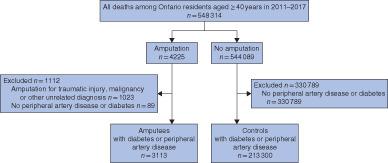当前位置:
X-MOL 学术
›
Br. J. Surg.
›
论文详情
Our official English website, www.x-mol.net, welcomes your
feedback! (Note: you will need to create a separate account there.)
End-of-life care following leg amputation in patients with peripheral artery disease or diabetes.
British Journal of Surgery ( IF 8.6 ) Pub Date : 2019-10-14 , DOI: 10.1002/bjs.11367 C de Mestral 1, 2, 3, 4 , A T Hsu 3, 5, 6 , R Talarico 3 , D S Lee 3, 7 , M A Hussain 2 , K Salata 1, 2, 3 , M Al-Omran 1, 2, 4, 8 , P Tanuseputro 3, 5, 6
British Journal of Surgery ( IF 8.6 ) Pub Date : 2019-10-14 , DOI: 10.1002/bjs.11367 C de Mestral 1, 2, 3, 4 , A T Hsu 3, 5, 6 , R Talarico 3 , D S Lee 3, 7 , M A Hussain 2 , K Salata 1, 2, 3 , M Al-Omran 1, 2, 4, 8 , P Tanuseputro 3, 5, 6
Affiliation

|
BACKGROUND
The aim was to characterize end-of-life care in patients who have had a leg amputated for peripheral artery disease (PAD) or diabetes.
METHODS
This was a population-based retrospective cohort study of patients with PAD or diabetes who died in Ontario, Canada, between 2011 and 2017. Those who had a leg amputation within 3 years of death were compared with a control cohort of deceased patients with PAD or diabetes, but without leg amputation. The patients were identified from linked health records within the single-payer healthcare system. Place and cause of death, as well as health services and costs within 90 days of death, were compared between the amputee and control cohorts. Among amputees, multivariable regression models were used to characterize the association between receipt of home palliative care and in-hospital death, as well as time spent in hospital at the end of life.
RESULTS
Compared with 213 300 controls, 3113 amputees were less likely to die at home (15·5 versus 24·9 per cent; P < 0·001) and spent a greater number of their last 90 days of life in hospital (median 19 versus 8 days; P < 0·001). Amputees also had higher end-of-life healthcare costs across all sectors. However, receipt of palliative care was less frequent among amputees than controls (inpatient: 13·4 versus 16·8 per cent, P < 0·001; home: 14·5 versus 23·8 per cent, P < 0·001). Among amputees, receipt of home palliative care was associated with a lower likelihood of in-hospital death (odds ratio 0·49, 95 per cent c.i. 0·40 to 0·60) and fewer days in hospital (rate ratio 0·84, 0·76 to 0·93).
CONCLUSION
Palliative care is underused after amputation in patients with PAD or diabetes, and could contribute to reducing in-hospital death and time spent in hospital at the end of life.
ANTECEDENTES
Caracterizar la atención al final de la vida en pacientes con amputación de la extremidad inferior por enfermedad arterial periférica (peripheral arterial disease, PAD) o diabetes. MÉTODOS: Se trata de un estudio de cohortes retrospectivo de base poblacional en sujetos fallecidos con PAD o diabetes en Ontario, Canadá (2011-2017). A partir de los registros sanitarios incluidos en un sistema de salud de una sola entidad pagadora, se identificaron los individuos con amputación de la extremidad inferior en los 3 años previos al fallecimiento y una cohorte control de fallecidos con PAD o diabetes sin amputación. Entre las cohortes de amputados y controles se comparó el lugar del fallecimiento y la causa, así como el uso de servicios sanitarios y costes en los últimos 90 días de vida. En el grupo de los amputados, se utilizaron modelos de regresión para caracterizar la asociación entre recibir cuidados paliativos domiciliarios y el fallecimiento en el hospital, así como los días de estancia hospitalaria al final de la vida.
RESULTADOS
En comparación con los controles (n = 213.300), los sujetos con amputación (n = 3.113) era menos probable que fallecieran en el domicilio (16% versus 25%, P < 0,001) y pasaron un mayor número de sus últimos 90 días de vida en el hospital (mediana 19 versus 8 días, P < 0,001). Los costes de atención sanitaria al final de la vida en todos los sectores también fueron mayores para los amputados. Sin embargo, recibir cuidados paliativos fue menos frecuente en los amputados que en los controles (en el hospital 13% versus 17%, P < 0,001; domiciliarios 14% versus 24%, P < 0,001). En el grupo de los amputados, recibir cuidados paliativos domiciliarios se asociaba con una menor probabilidad de fallecimiento en el hospital (razón de oportunidades, odds ratio 0,49, i.c. del 95% 0,40-0,60) y menos días de hospitalización (tasa de riesgo 0,84, i.c. del 95% 0,76-0,93). CONCLUSIÓN: Los cuidados paliativos están infrautilizados en pacientes con PAD o diabetes y pueden contribuir a disminuir los fallecimientos en el hospital y los días de hospitalización al final de la vida.
中文翻译:

肢体动脉疾病或糖尿病患者截肢后的临终护理。
背景技术目的是表征腿部因外周动脉疾病(PAD)或糖尿病而被截肢的患者的临终护理。方法这是一项基于人群的回顾性队列研究,研究对象是2011年至2017年在加拿大安大略省死亡的PAD或糖尿病患者。将死亡3年以内的肢体截肢的患者与PAD死亡患者的对照组进行比较或糖尿病,但没有腿截肢。从单付款人医疗保健系统中的关联健康记录中识别出患者。比较了被截肢者和对照组的死亡地点和死亡原因,以及死亡后90天内的医疗服务和费用。在被截肢者中,使用多变量回归模型来表征接受家庭姑息治疗与住院死亡之间的关联,以及生命终结时在医院度过的时间。结果与213300名对照组相比,有3113名截肢者在家中死亡的可能性更低(15%对24 9%; P <0 001),并且他们在医院的最后90天的死亡时间更长(中位数为19天对8天) ; P <0·001)。在所有行业中,截肢者的临终医疗费用也较高。但是,被截肢者接受姑息治疗的频率低于对照组(住院患者:13·4比16·8%,P <0·001;家庭:14·5比23·8%,P <0·001) 。在被截肢者中,接受家庭姑息治疗与住院死亡的可能性较低(赔率049,95%ci 040至060)和住院天数较少(比率084、0·76至0·93)有关。结论PAD或糖尿病患者截肢后姑息治疗未得到充分利用,并可能有助于减少医院内的死亡和生命终结时的住院时间。背景技术为了表征由于外周动脉疾病(PAD)或糖尿病而导致的下肢截肢患者的临终护理。方法:这是一项对加拿大安大略省(2011-2017年)死者患有PAD或糖尿病的受试者进行的一项基于人群的回顾性队列研究。从单个付费实体的健康系统中包含的健康记录中,确定死亡前3年内有下肢截肢的个人以及死于PAD或糖尿病而没有截肢的对照组。在被截肢者和对照组之间,比较了死亡地点和原因,以及在生命的最后90天内使用医疗服务和费用。在被截肢者组中,使用回归模型来描述接受家庭姑息治疗与住院死亡之间以及生命终期住院天数之间的关联。结果与对照组(n = 213,300)相比,被截肢者(n = 3,113)在家中死亡的可能性更低(16%对25%,P <0.001),并且他们在医院的最后90天的生活时间更长(中位数19对8天,P <0.001)。被截肢者在所有行业的生命终结时的医疗保健费用也较高。尽管如此,被截肢者接受姑息治疗的频率低于对照组(医院中13%比17%,P <0.001;家庭14%比24%,P <0.001)。在截肢者组中,接受家庭姑息治疗与住院死亡的可能性较低(机会比率,优势比为0.49、95%CI为0.40-0.60)和住院天数较少(风险率为0.84、95%CI为0.76-0.93) )。结论:PAD或糖尿病患者的姑息治疗未得到充分利用,可有助于减少医院死亡和生命终止后的住院天数。接受家庭姑息治疗与住院死亡的可能性较低(赔率,优势比为0.49、95%CI为0.40-0.60)和住院天数较少(风险率为0.84、95%ic为0.76-0.93)有关。结论:PAD或糖尿病患者的姑息治疗未得到充分利用,可以帮助减少住院死亡和生命终止后的住院天数。接受家庭姑息治疗与住院死亡的可能性较低(赔率,优势比为0.49、95%CI为0.40-0.60)和住院天数较少(风险率为0.84、95%ic为0.76-0.93)有关。结论:PAD或糖尿病患者的姑息治疗未得到充分利用,可有助于减少医院死亡和生命终止后的住院天数。
更新日期:2019-10-14
中文翻译:

肢体动脉疾病或糖尿病患者截肢后的临终护理。
背景技术目的是表征腿部因外周动脉疾病(PAD)或糖尿病而被截肢的患者的临终护理。方法这是一项基于人群的回顾性队列研究,研究对象是2011年至2017年在加拿大安大略省死亡的PAD或糖尿病患者。将死亡3年以内的肢体截肢的患者与PAD死亡患者的对照组进行比较或糖尿病,但没有腿截肢。从单付款人医疗保健系统中的关联健康记录中识别出患者。比较了被截肢者和对照组的死亡地点和死亡原因,以及死亡后90天内的医疗服务和费用。在被截肢者中,使用多变量回归模型来表征接受家庭姑息治疗与住院死亡之间的关联,以及生命终结时在医院度过的时间。结果与213300名对照组相比,有3113名截肢者在家中死亡的可能性更低(15%对24 9%; P <0 001),并且他们在医院的最后90天的死亡时间更长(中位数为19天对8天) ; P <0·001)。在所有行业中,截肢者的临终医疗费用也较高。但是,被截肢者接受姑息治疗的频率低于对照组(住院患者:13·4比16·8%,P <0·001;家庭:14·5比23·8%,P <0·001) 。在被截肢者中,接受家庭姑息治疗与住院死亡的可能性较低(赔率049,95%ci 040至060)和住院天数较少(比率084、0·76至0·93)有关。结论PAD或糖尿病患者截肢后姑息治疗未得到充分利用,并可能有助于减少医院内的死亡和生命终结时的住院时间。背景技术为了表征由于外周动脉疾病(PAD)或糖尿病而导致的下肢截肢患者的临终护理。方法:这是一项对加拿大安大略省(2011-2017年)死者患有PAD或糖尿病的受试者进行的一项基于人群的回顾性队列研究。从单个付费实体的健康系统中包含的健康记录中,确定死亡前3年内有下肢截肢的个人以及死于PAD或糖尿病而没有截肢的对照组。在被截肢者和对照组之间,比较了死亡地点和原因,以及在生命的最后90天内使用医疗服务和费用。在被截肢者组中,使用回归模型来描述接受家庭姑息治疗与住院死亡之间以及生命终期住院天数之间的关联。结果与对照组(n = 213,300)相比,被截肢者(n = 3,113)在家中死亡的可能性更低(16%对25%,P <0.001),并且他们在医院的最后90天的生活时间更长(中位数19对8天,P <0.001)。被截肢者在所有行业的生命终结时的医疗保健费用也较高。尽管如此,被截肢者接受姑息治疗的频率低于对照组(医院中13%比17%,P <0.001;家庭14%比24%,P <0.001)。在截肢者组中,接受家庭姑息治疗与住院死亡的可能性较低(机会比率,优势比为0.49、95%CI为0.40-0.60)和住院天数较少(风险率为0.84、95%CI为0.76-0.93) )。结论:PAD或糖尿病患者的姑息治疗未得到充分利用,可有助于减少医院死亡和生命终止后的住院天数。接受家庭姑息治疗与住院死亡的可能性较低(赔率,优势比为0.49、95%CI为0.40-0.60)和住院天数较少(风险率为0.84、95%ic为0.76-0.93)有关。结论:PAD或糖尿病患者的姑息治疗未得到充分利用,可以帮助减少住院死亡和生命终止后的住院天数。接受家庭姑息治疗与住院死亡的可能性较低(赔率,优势比为0.49、95%CI为0.40-0.60)和住院天数较少(风险率为0.84、95%ic为0.76-0.93)有关。结论:PAD或糖尿病患者的姑息治疗未得到充分利用,可有助于减少医院死亡和生命终止后的住院天数。











































 京公网安备 11010802027423号
京公网安备 11010802027423号